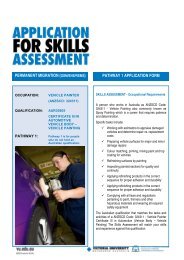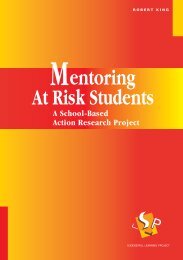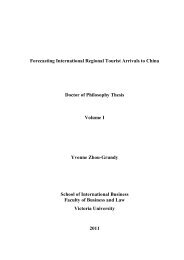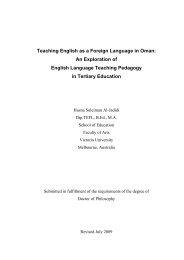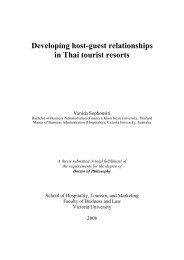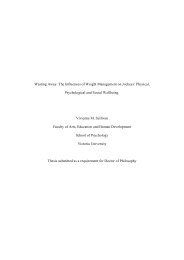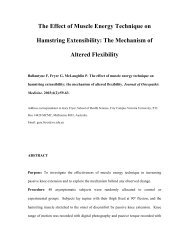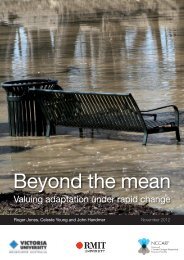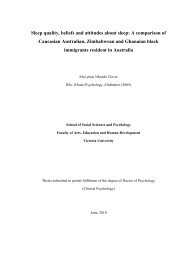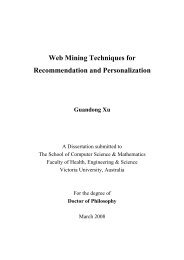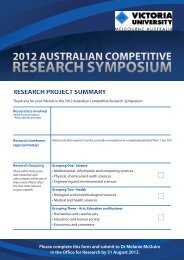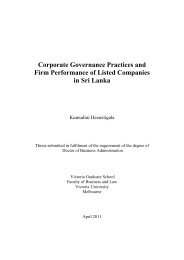e ‘returning to study’ will have moved far beyond these settings anyway, in terms of lifeexperience. We can unequivocally state that adult learning strategies must be at the heart ofprograms <strong>for</strong> alienated youth, <strong>and</strong> at the heart of those strategies is a respect <strong>for</strong> the experientialauthenticity of the learner.For this reason, it is important to agree with the plea from Anderson et al., <strong>for</strong> respect <strong>for</strong>classroom diversity - ‘the conceptualising of disadvantage needs to accommodate diversity<strong>and</strong> difference <strong>and</strong> to acknowledge their link with systematic patterns of disadvantage <strong>and</strong>inequality’. They, <strong>and</strong> we, can offer no prescription <strong>for</strong> success. What is essential is a centralrecognition that ‘one shoe fits all’ is no longer (if it ever was) an adequate design feature <strong>for</strong>young people’s learning.Re-Thinking InstitutionsTraditional senior secondary schooling <strong>and</strong> traditional TAFE teaching, facing the newworld of workplace learning, would seem, on this evidence, to be in tension with it.Moreover, the new regard <strong>for</strong> young people as adult learners spills over into their nonschoollives. They are expected to take decisions framed by a host of sexual, gender, ethnic,religious, ability <strong>and</strong> family dimensions. Maturity - that is, a capacity <strong>for</strong> independent judgment- <strong>for</strong> that decision-making is, rightly or wrongly, imputed to young people from mid-teensonwards. The immediate concern, given this as a basis <strong>for</strong> policy <strong>and</strong> practices <strong>for</strong> alienatedyouth, is captured by Robyn Hartley, in an address to the Youth Affairs Council of <strong>Victoria</strong> in1995, when she stated:…the lines between dependence <strong>and</strong> independence in relation to young people are nolonger clearly drawn <strong>and</strong> there are many different patterns <strong>and</strong> combinations…Forexample, young people can live with their parents <strong>and</strong> be largely socially <strong>and</strong> financiallyindependent; they can live away from home <strong>and</strong> be financially supported by their parents.On the other h<strong>and</strong>, about one-quarter of the young people living ‘independently’ areliving in poverty. What, we may ask, in the meaning of independence in thesecircumstances? Isn’t it more productive to recognise the crucial role which interdependenceplays in all of our lives? (1996:4)Yet government policies, especially initiatives like the Commonwealth Youth Allowance, mayhave the effect of constructing distinctions between types of participants in, <strong>and</strong> recipients of,programs, which tend to fragment the experiences of young people in unhelpful ways. Thedifferential between over <strong>and</strong> under 18-year-olds, now emerging in the Youth Allowance, willinevitably have an impact on the sort of provision which schools <strong>and</strong> other program agencieswill try to develop. This is not least because there will be repercussions within families whensome members (under 18 yrs.) st<strong>and</strong> in more overtly supplicant relations to government welfare,compared to others (over 18 yrs.). Hartley draws our attention to the policy difficulties inherentin categorising participation, <strong>and</strong> she is right.Whilst this project is not centrally concerned with the categorisation of participants, it islegitimately mindful of the need <strong>for</strong> institutions <strong>and</strong> community agencies to design programs<strong>for</strong> such participants which, first, respect the inter-dependent nature of young adults’experiences, <strong>and</strong>, second, recognise that these inter-dependencies are locally negotiated.25
The research literature on ‘alienated’ or at-risk youth is clear that the focus of well-designedprograms can be found in their allegiance to the experiential integrity of the young peoplethemselves. But schools, at least, if Ryan <strong>and</strong> Sercombe are right, will have to change out ofall recognition if ‘alienated youth’ programs are to be mainstreamed. Just getting a traditionalsenior secondary environment to seriously consider adult learning strategies in its classroomsis a large task. The further task of moving those strategies into shop-front or other communitysettings down around the corner - ‘mainstreeting’ the mainstream - is a massive hope.Worthwhile program design does, however, require that kind of hope. Alienated youth,especially those who may be attracted back to successful studies, such as the Youth Allowanceintends, are unlikely to return to an environment which itself alienated them, in the first place.But examples of worthwhile program design in schools in <strong>Victoria</strong> already exist. Batten (1989)in her detailed research on the STC course, concluded that, although ‘evidence of its success<strong>and</strong> influence is not hard to find’, it would ‘not be able to continue in its present <strong>for</strong>m after1991’ (p217). This situation arose initially because of the inadequacy of the traditional narrowlyfocussed academic HSC, which was eroding school retention <strong>and</strong> student participation. It wasthe ‘Blackburn Report’ into post-compulsory schooling (1985), in its support <strong>for</strong> a singlecertificate, which denied the continuation of whole-course school-based curriculum diversity.This meant that, while the new two-year <strong>Victoria</strong>n Certificate of <strong>Education</strong>, phased in between1989 <strong>and</strong> 1992, was serious about practical studies, <strong>and</strong> studies of work, it was not able tomeld these to any vocational, as opposed to academic, purposes. Yet the education researcher,Dean Ashenden (in Batten: 217), claimed of the STC course:The <strong>Victoria</strong>n STC program is easily the best <strong>and</strong> most successful of the Australianattempts at an ‘alternative’ approach to democratic education. It has grown quickly [43schools in 1984; 117 schools in 1987]. It has succeeded in keeping at school many kidswho would otherwise have left. (emphasis added)The STC course had a set of educational principles, presented as a set of Course Intentions,<strong>and</strong> as a Checklist. The Checklist urged a whole-school program, within which:Classes should be organised on the basis of—close student-teacher <strong>and</strong> student-student interaction;—co-operation rather than competition;—heterogenous grouping;—commitment to the success of all individuals;—challenging, worthwhile units of work that reflect the everyday experiences of allstudents;—units which reflect the diverse character of society;—units which achieve a balance of action <strong>and</strong> reflection;—<strong>and</strong> which integrate theoretical <strong>and</strong> applied knowledge. (Freeman 1987:5)STC, even with inclusivity (as above) as its core concept, along with its cousins (the TOP <strong>and</strong>the T12 certificates) were always on the educational margins, even although they successfullytargeted ‘at risk’ students. Now, ten years since Blackburn, Keating (1995) concludes his analysisof the implications <strong>for</strong> Australian schools of vocational education <strong>and</strong> training by claimingthat training re<strong>for</strong>ms challenge that marginalisation:26
- Page 2 and 3: Providing Education and Trainingfor
- Page 4 and 5: ForewordThe Commonwealth Government
- Page 6 and 7: ContentsForeword 3Acknowledgments 4
- Page 8 and 9: Executive SummarySuccessful learnin
- Page 10: program leaders (at least) to meet
- Page 13 and 14: The major outcome sought from this
- Page 15 and 16: Data was entered in categories unde
- Page 17 and 18: 2Literature ReviewBenchmark 1995Sub
- Page 19 and 20: It is likely that a significant gro
- Page 21 and 22: Indeed, these ‘messages’ have b
- Page 23 and 24: In this we look at labour market sk
- Page 25: Individuals appear to perform bette
- Page 29 and 30: ConclusionPathways are notoriously
- Page 31 and 32: 3Mapping the FieldThe Stage 1 inter
- Page 33 and 34: Wilderness Enhancement Program, ATL
- Page 35 and 36: them from progressing or even parti
- Page 37 and 38: 4Program ModelsAnumber of the 19 pr
- Page 39 and 40: 3. All students are case managed.4.
- Page 41 and 42: (i) accommodating student diversity
- Page 43 and 44: Teachers involved in the course hav
- Page 45 and 46: There are VET subjects, of which th
- Page 47 and 48: This approach helps the transition
- Page 49 and 50: Young people are referred to the pr
- Page 51 and 52: to become contributing members of t
- Page 53 and 54: Rules are negotiated with the young
- Page 55 and 56: 5Characteristics of Programs That W
- Page 57 and 58: The review processes that already e
- Page 59 and 60: attitude to learning and enhanced s
- Page 61 and 62: 6Conclusion and RecommendationsMr G
- Page 63 and 64: 2.4 That program activities include
- Page 65 and 66: ReferencesACFE Board (1998) Young a
- Page 67 and 68: Withers, G. and Batten, M. (1995) P
- Page 69 and 70: Successful learning projectsDraft o
- Page 71 and 72: Successful learning projects 1998Dr
- Page 73 and 74: Program and LocationTarget Group, P
- Page 75 and 76: Program and LocationTarget Group, P
- Page 77 and 78:
Program and LocationTarget Group, P
- Page 79 and 80:
Program and LocationTarget Group, P
- Page 81 and 82:
Program and LocationTarget Group, P
- Page 83 and 84:
Program and LocationTarget Group, P
- Page 85 and 86:
Program and LocationTarget Group, P
- Page 87 and 88:
Program and LocationTarget Group, P
- Page 89 and 90:
Program and LocationTarget Group, P
- Page 91 and 92:
Program and Location- Certificate i
- Page 93 and 94:
Program and LocationTarget Group, P
- Page 95 and 96:
Program and LocationTarget Group, P
- Page 97 and 98:
Program and LocationTarget Group, P
- Page 99 and 100:
Program and LocationTarget Group, P
- Page 101 and 102:
Program and LocationTarget Group, P
- Page 103 and 104:
Program and LocationCambodian Youth
- Page 105:
APPENDIX IIICURRICULUM OUTLINE FOR



